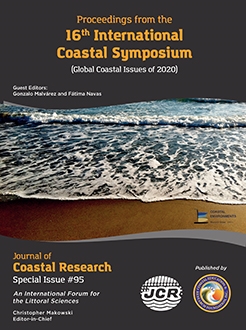Fraile-Jurado, P; Guisado-Pintado, E.; Álvarez-Francoso, J.; Díaz-Cuevas, P., and Ojeda-Zújar, J., 2020. Wave energy patterns under different sea-level rise (SLR) probabilities in the Andalusian Atlantic coast In: Malvárez, G. and Navas, F. (eds.), Global Coastal Issues of 2020. Journal of Coastal Research, Special Issue No. 95, pp. 1088–1093. Coconut Creek (Florida), ISSN 0749-0208.
Sea Level Rise (SLR) derived impacts in coastal areas has become a subject of increasing concern particularly in low-lying coastal stretches. Synergetic effects with increasing storminess and wind-wave climate variability is expected to force sandy coastlines to accommodate to new forcing conditions. Previous studies have used SLR scenarios to evaluate expected changes in shoreline position and to create flooding vulnerability maps, among others applications. Less common are the studies that use a combine approach to determine the expected changes of certain wave hydrodynamics parameters based on a single probability value of P = 0.5 in order to determine future SLR changes. Nevertheless, SLR scenarios developed by IPCC involve a probability model with centrality and dispersion parameters that allow matching probability values and future SLR and therefore to derive different site-specific probability scenarios. In the this work we present an integrated approach that assess the influence of different sea level rise scenarios (calculated based on local probabilities) on wave energy patterns using a wave propagation model in a mesotidal coast in southwestern Spain. The local probabilities spectrum is calculated through the integration of the observed sea level rise trends from the local tide gauge and by using the centrality and deviation parameters of the IPCC scenario RCP8.5. Five SLR probabilities were used in the nearshore wave simulations, corresponding to P < 0.99 (+0.20 m), P < 0.75 (+0.56 m), P < 0.5 (+0.7 m), P < 0.25 (+0.86 m), P < 0.01 (+1.20 m) and P = 1 as the current sea level. These five scenarios were run under modal and high energy wave conditions established from 15-year long wave time series. The results show a diverse hydrodynamic behavior that seems to be driven by a combination of factors such as the morphological conditions, beach orientation and platform steepness. Further, the presence of cross-shore rocky platforms influences wave energy propagation patterns for the different analyzed probability cases. The study helps to understand future coastal behavior under a SLR scenario though some limitations are acknowledged as the approach does not include the continuous morphological adaptation of the site to sea level rise.





